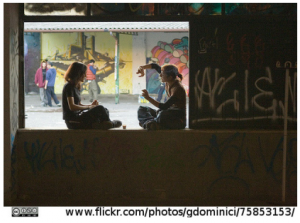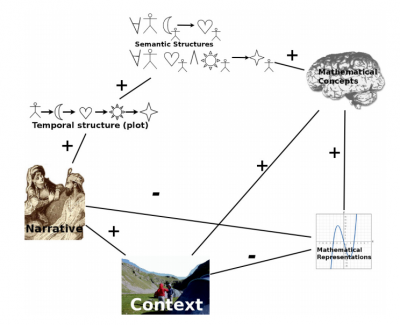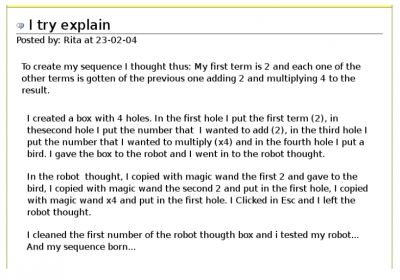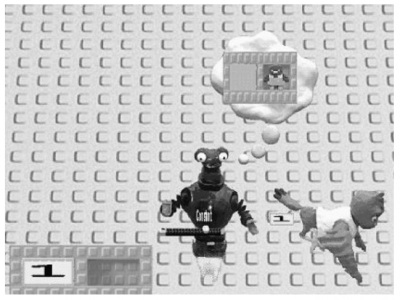Narrative Spaces/OG
| Narrative Spaces | |
| Contributors | Yishay Mor |
|---|---|
| Last modification | May 16, 2017 |
| Source | Mor (2008)[1] |
| Pattern formats | OPR Alexandrian |
| Usability | |
| Learning domain | |
| Stakeholders | |
Constructing narrative is a fundamental mechanism for making sense of events and observations. To leverage it, we must give learners opportunities to express themselves in narrative form.
The problem
How can the epistemic power of narrative be harnessed by educators and learners in the construction of mathematical meaning?
Forces
• Narrative is a powerful cognitive and epistemological construct[2][3][4]
• Mathematics appears to be antithetical to narrative form, which is always personal, contextual and time-bound.
Context
Digital environments for collaborative learning of mathematics.
Solution
Provide learners with a narrative space: a medium, integrated with the activity design, which allows learners to express and explore ideas in a narrative form:
• Allow for free-form text, e.g. by supporting Soft Scaffolding (Soft Scaffolding).
• Choose Narrative Representations (Narrative Representations) when possible.
Mark narrative elements in the medium:
• Clearly mark the speaker / author, to support a sense of voice.
•Date contributions to support temporal sequentiality ('plot').
•Use Semi-Automated Metadata (Semi-Automated Metadata) to provide context.
Examples
The webreports system allowed learners to comment on any page using a free-form WYSWYG editor (Figure 2). This allowed them to express their mathematical ideas in a personal narrative, as well as the path by which they arrived at these ideas. Using this feature, learners expressed and developed arguments which they could not yet formalize, and shared their learning process.
One participant in the guess my robot gameused ToonTalk robots in an unexpected way: he trained the robot to “act out” the way in which he solved a challenge (Figure 3).
Related Patterns
Uses: Narrative Representations (Narrative Representations); Objects to Talk With (Objects to Talk With); Semi-Automated Metadata (Semi-Automated Metadata)
Used by: Guess My X (Guess My X)
References
- ↑ Mor, Y. (2008). Guess my X and other Techno-pedagogical Patterns: Toward a Language of Patterns for Teaching and Learning Mathematics. In Proceedings of the 13th European Conference on Pattern Languages of Programs (EuroPLoP 2008). New York:ACM
- ↑ Bruner, J. (1986). Actual minds, possible worlds (The Jerusalem-Harvard lectures).
- ↑ Bruner, J. (1990). Acts of Meaning: Four Lectures on Mind and Culture (Jerusalem-Harvard Lectures).
- ↑ Bruner, J. (1991). The narrative construction of reality. Critical inquiry, 18(1), 1-21.



